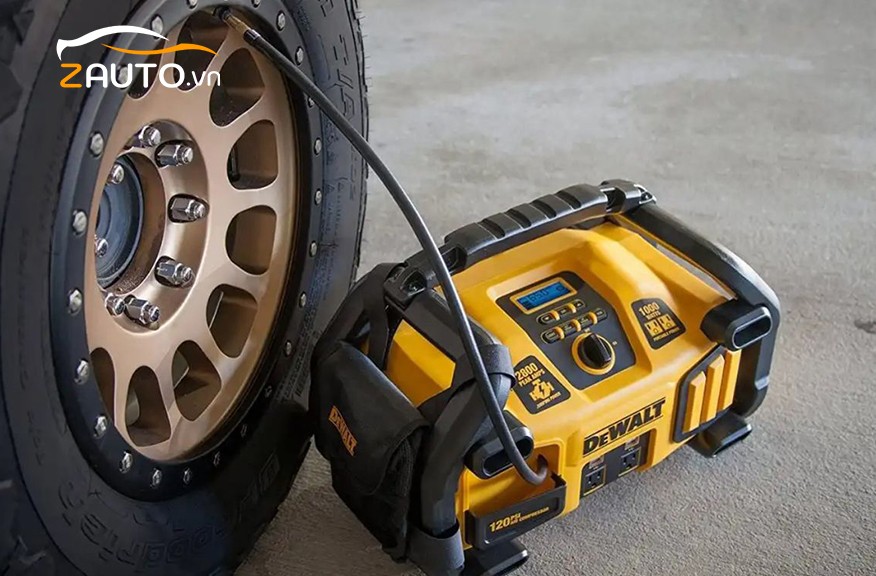Pickup trucks are increasingly popular in Vietnam due to their versatility, power, and ability to handle various terrains. To ensure your truck operates stably, safely, and durably, maintaining the correct tire pressure is crucial. Tire pressure directly impacts road grip, driving comfort, tire lifespan, and fuel efficiency. This article from Xe Tải Mỹ Đình (My Dinh Truck), your truck experts, will provide detailed information on how to properly inflate pickup truck tires and the most accurate standard pressure levels.
Why is Tire Pressure Important for Pickup Trucks?
Tire pressure plays a pivotal role in the performance and safety of your pickup truck. Here are the main reasons why you should pay close attention to your truck’s tire pressure:
- Optimize Road Grip and Control: Correct tire pressure helps your pickup truck achieve optimal road grip, especially crucial in challenging driving conditions such as rain, slippery roads, mud, or hilly and rough terrain. Under-inflated or over-inflated tires can reduce the contact area between the tire and the road surface, leading to loss of control, skidding, and endangering the driver and surrounding vehicles.
- Save Fuel: When tires are inflated to the correct pressure, the rolling resistance of the tires is significantly reduced. This helps the vehicle move more easily and smoothly, thereby reducing fuel consumption. Conversely, under-inflated tires increase rolling resistance, forcing the engine to work harder to maintain speed, leading to increased fuel consumption.
- Extend Tire Lifespan: Maintaining proper tire pressure helps tires wear evenly and last longer. Over-inflated tires cause the center of the tire to bear more pressure and wear out faster. Meanwhile, under-inflated tires cause the edges of the tire to bear more load, leading to uneven wear and premature damage.
- Smooth and Comfortable Ride: With the correct tire pressure, your pickup truck operates more stably, minimizing vibrations and noise from the tires transmitted into the cabin. This provides greater comfort and ease for both the driver and passengers, especially on long journeys or rough roads.
 Checking tire pressure on a pickup truck
Checking tire pressure on a pickup truck
What is the Ideal Tire Pressure for Pickup Trucks?
The ideal tire pressure for pickup trucks is not a fixed number but depends on various factors, including:
- Type of Tire: Each tire type has different recommended pressure specifications. This information is usually printed on the tire sidewall or in the vehicle’s owner’s manual.
- Vehicle Load: When the vehicle is carrying heavy loads or towing a trailer, the tire pressure needs to be increased to accommodate the increased weight and ensure safety.
- Operating Conditions: When driving on highways, freeways, or off-road terrain, the tire pressure may need to be adjusted to suit specific conditions.
However, to make it easier for you to inflate your pickup truck tires, we provide some general guidelines on recommended tire pressure levels:
- When the vehicle is unloaded or lightly loaded: The recommended tire pressure is usually in the range of 2.1 to 2.4 kg/cm² (equivalent to 30 to 35 psi). This pressure level is suitable for smooth vehicle operation, fuel efficiency, and ensuring good road grip under normal driving conditions.
- When the vehicle is carrying heavy loads or towing a trailer: You need to increase the tire pressure to about 2.7 to 3.0 kg/cm² (equivalent to 40 to 45 psi) to accommodate the increased load and ensure safe operation. Increasing tire pressure helps the tires bear heavier loads better, preventing excessively under-inflated tires which can be dangerous.
- When driving on rough terrain (sand, gravel, mud): In off-road conditions, you can reduce the tire pressure to about 1.7 to 2.0 kg/cm² (equivalent to 25 to 29 psi). Reducing tire pressure increases the contact area of the tire with the road surface, improving road grip and off-road capability, while also reducing the risk of tire damage from impacts with rocks or obstacles.
Illustration image of where to find recommended tire pressure information on a pickup truck tire sidewall.
Detailed Guide on How to Check and Adjust Pickup Truck Tire Pressure
To ensure your pickup truck’s tire pressure is always at the standard level, you need to perform regular checks. Below are detailed steps on how to check and inflate pickup truck tires correctly:
Step 1: Prepare Tools
You need to prepare some necessary tools to check and inflate pickup truck tires, including:
- Tire Pressure Gauge: Choose a mechanical or digital tire pressure gauge with high accuracy. Regularly check and maintain the gauge to ensure accurate readings.
- Air Pump: Use a hand pump, electric pump, or air compressor at service stations to inflate pickup truck tires.
- Clean Cloth: Use to wipe away dirt from the tire valve before measuring and inflating.
Step 2: Check Tire Pressure When Tires are Cold
The best time to check tire pressure is when the tires are cold, i.e., after the vehicle has been parked for at least 3 hours or has traveled a short distance of less than 1-2 km. When tires heat up due to friction with the road surface, the pressure inside the tires will increase, leading to inaccurate readings.
Step 3: Measure Tire Pressure
- Locate the Tire Valve: The tire valve is usually located in an easily visible position on the wheel rim.
- Remove the Valve Cap: Gently unscrew the valve cap counterclockwise to remove it and store it carefully.
- Connect the Pressure Gauge: Place the end of the pressure gauge onto the tire valve and press lightly, holding it firmly to ensure no air escapes.
- Read the Measurement: Read the pressure value displayed on the pressure gauge. Compare the reading with the recommended pressure level printed on the tire sidewall or in the vehicle’s owner’s manual.
Step 4: Adjust Tire Pressure
- If Tire Pressure is Lower than Recommended: Use an air pump to inflate the pickup truck tire to the desired pressure level. Inflate slowly and recheck the pressure with the gauge frequently to avoid over-inflation.
- If Tire Pressure is Higher than Recommended: Use the pointed end of the pressure gauge or a small pointed object to gently press the air release pin in the tire valve. Release air slowly until the pressure reaches the recommended level. Recheck the pressure with the gauge after releasing air.
Step 5: Recheck and Complete
- Recheck Pressure: After adjusting, recheck the tire pressure with the gauge to ensure the pressure has reached the standard level.
- Install Valve Cap: Screw the valve cap tightly clockwise to protect the valve from dirt and air leaks.
- Repeat the Process: Repeat the same procedure for all remaining tires, including the spare tire.
Step 6: Remember and Check Regularly
- Remember Standard Pressure: Record the standard tire pressure for your pickup truck in an easily visible location (e.g., stick a label on the door or write it in a notebook).
- Regular Checks: Check tire pressure at least once a month or before each long trip. Regular checking and inflating pickup truck tires helps maintain tires in the best condition, ensuring safety and optimal operating performance.
 Reading a tire pressure gauge on a pickup truck tire
Reading a tire pressure gauge on a pickup truck tire
Conclusion
Inflating pickup truck tires to the correct pressure is not just a simple maintenance task but also a crucial factor in ensuring safety, saving fuel, and extending tire lifespan. We hope that with these detailed instructions from Xe Tải Mỹ Đình, you have gained more knowledge and skills to easily and effectively check and adjust your pickup truck’s tire pressure yourself. Always maintain your tire pressure at the standard level to experience a safe, smooth, and economical driving experience!
Contact Information:
- Free installation at your location in Ho Chi Minh City & surrounding areas
- Hotline / Zalo: 077 5189 672
